A falling tent heralded catastrophe.
Until the summer dry season comes, things in the Pacific Northwest are perpetually wet. Edward Smith and his companions, camped 18 kilometers (11 miles) north of Mount St. Helens, had set their tent on its side to dry out. At 8:32 am, an unusually strong wind gusted, again, and again: the tent tumbled, and a sound like a trio of rifle shots sounded. The surrounding pressure seemingly changed; they found themselves forced to the ground. And then the leading, black edge of the blast cloud soared overhead. Chunks of juvenile gray dacite fell like hail, some as large as golf balls. In the rock rain, Edward and his companions watched the cloud rush to the north before abruptly pulling back to the south. Blue sky appeared, briefly, though the black cloud never completely left his sight. Then the interlude ended. The blackness roared back. A cedar fell; seconds later, he told geologists, “there were no trees left.” They tumbled in eerie silence, in eerie stillness, no sensation of the blast that ripped them down. “Whatever happened,” Edward said, “it happened over our head.”
Cold, muddy ash possibly mixed with ice spattered them, somewhat larger than the sand-sized ash that would be ubiquitous elsewhere. Ash, later dry, fell so heavily they couldn’t see more than a foot even with a flashlight. The cool darkness turned hot a minute or so after the trees fell: it didn’t last long, but while it did, it gave the impression of forest fires raging nearby.
Edward Smith and his friends had just survived a lateral blast and the destruction of a forest without benefit of protective vehicles. They were extremely lucky. Others wouldn’t survive so unscathed.

Three kilometers (about 1 mile) north of Edward, 21 kilometers (13 miles) from Mount St. Helens, Danny Balch and Brian Thomas differ on the pressure change issue: one may have felt it, while the other did not. But there was an odd sense that set them both looking for a source of the sensation, whatever it was. Brian looked through their tent flap to the west, and the sight must have poured ice into his blood: a red column rising to dizzying heights. He scrambled from the tent and took shelter under a tree toppled by time or storms long before the eruption. He’d barely reached huddled shelter beneath the log when the blast hit with a rumble. Trees toppled around the log he was under: one struck him, breaking his hip. “I was just instantly buried,” he told interviewing geologists.
Out in the open, Danny found himself knocked sprawling by the arriving blast. He reached out, probing the sudden darkness with his hands, and found logs. He dragged himself up as muddy, icy material fell, melting as it hit, soaking him. The cold only lasted for a few seconds before the air around him became so hot it dried him nearly instantly before burning his hands, scalp and other exposed areas. Brian, semi-safely buried a few feet away, wasn’t burned, but could feel the heat. The searing part of the blast passed quickly, but the air remained hotter than a midday, midsummer desert for some time. A chunky rain of debris fell for several minutes, cutting their visibility down to no more than a foot, often less. It stopped falling suddenly, they say: “Then it was almost sunny.” The main part of the blast had passed, leaving a deposit 8-10 centimeters (3-4 inches) deep. Minutes passed before ash began to fall.
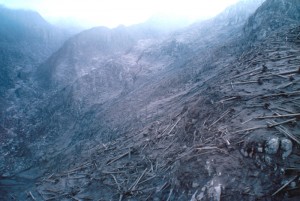
Not far from Brian and Danny’s camp, a quartet had watched the initial strong wind blow their campfire flames flat, lapping at the ground. Braids blew horizontally. No one heard a sound – no explosion, no cracks or “shots,” no grinding of falling trees – but within fifteen seconds of the wind gusting, blackness arrived and all of the trees came down. Sue Ruff and Bruce Nelson found themselves buried in timber and ash. Fortunately, they had fallen into the cavity left by the ripped-out root ball of a fallen tree. Their companions, Karen Varner and Terry Crall, weren’t so fortunate.
Sue and Bruce huddled in the darkness, able to speak but unable to see each other. The air warmed a few seconds after they were buried, growing so hot their hair sizzled. Bruce, a baker, compared that singing warmth to a 300°F (150°C) oven: it cooked the trees, forcing pitch to boil out, remaining so hot for several minutes that it could burn. In their hot, debris-filled nest, they watched the sky clear suddenly after several minutes of darkness, before the ash fall began. They climbed out, calling for their friends – but Karen and Terry were dead.
Sue and Bruce did find Danny and Brian, however. They helped build a shelter for Brian. Danny’s shoes couldn’t be found, and the ash was too hot to hike through barefoot, so Sue and Bruce set out on their own. They would encounter another survivor, Grant Christiansen (not interviewed by the USGS), and a few hours later flagged down a helicopter to carry them, Brian and Danny to safety.
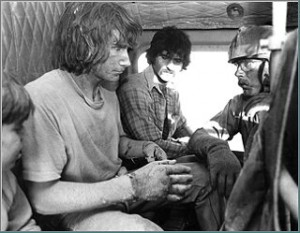
They were all in the direct path of the northward blast. Another group, four loggers at work in the forest that sunny Sunday morning, were 20 kilometers (12 miles) to the northwest along the North Fork Toutle River valley. Mount St. Helens hid behind a ridge; with their view blocked, James Scymanky, Leonty Skorohodoff, and Evlanty Sharipoff had no idea anything had happened until Jose Dias ran toward them, shouting: he’d seen the mountain erupt. Just about ten seconds later, James heard “a horrible, crashing, crunching, grinding sound” advancing through the forest from Mount St. Helens, and darkness fell, cutting off their vision. James doesn’t remember an interval of cold material falling. Instead, they were subjected almost instantly to intense heat. As they struggled to breathe in the thick, stifling, debris-laden darkness, they pulled in air and ash hot enough to sear their mouths and throats. James was knocked to the ground – not by a rock or falling tree, to the best of his recollection, but something toppled him. When he rose, he found his back being seared by incredible heat that lasted an intolerable two minutes. Hot as the blast was, it didn’t burn their clothes, just their skin.
When the heat passed, the blast cloud ended, and visibility returned, the men found themselves in a gray wasteland. Toppled trees were coated in a foot of ash. Twenty minutes later, as they picked an agonizing path through the debris, trying to find a way out, ash began falling again.
They’d been burned inside and out: only James survived.
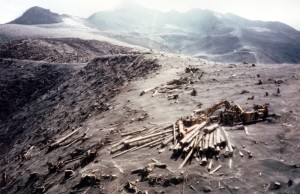
Outside of the blast zone, witnesses watched from a safe distance as the blast cloud rolled and roared over ridges, tossed trees like sticks at its leading edge, and continued on with implacable force until something seemed to stand it up. Several described it that way: as if it had hit a wall, the blast stopped, recoiled, rose vertically. It lifted so abruptly it left a clear, thin line of singed trees standing between complete destruction and healthy forest.
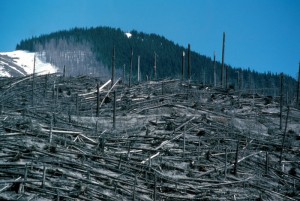
It rolled up into the sky, joining the emerging eruption column. The lateral blast, an event no one had expected, had ended almost as quickly as it was unleashed. But Mount St. Helens had an entire repertoire of volcanic events to demonstrate. The eruption was far from over.
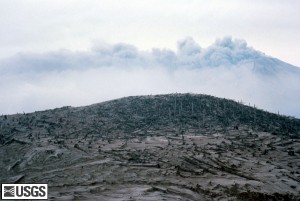
Previous: The Cataclysm: “A Boiling Mass of Rock.”
Next: Interlude: When Vehicles Become Part of the Geologic Record.
References:
Fisher, R.V; Heiken, G. and Hulen, J. (1998): Volcanoes: Crucibles of Change. New Jersey: Princeton University Press.
Lipman, Peter W., and Mullineaux, Donal R., Editors (1981): The 1980 Eruptions of Mount St. Helens, Washington. U.S. Geological Survey Professional Paper 1250.


It all happens so fast.
How do people in movies outrun these things??
The pickup picture reminds me of what was to me the most chilling scene in the aftermath of the eruption: A pickup with a dead child in the back. I quickly began to wish they’d quit showing it. I remember it both before and after the placement of a large colored ribbon indicating that rescue workers had checked the scene.
Dana’s vivid descriptions make clear how utterly terrifying it must have been to be caught up in it. The picture showing downed trees, singed trees, and living trees in close proximity is striking evidence of the directional nature of the blast, and shows that survival depended as much on being in the right place as did courage and resourcefulness.
Trebuchet – totally OT, and not intended to derail, but I think you need a vacation home in Michigan. Be sure to look at the slideshow.
Oh my yes! Fresnel lens and the whole nine yards. Just needs a catapult by the lakeside….
I think the right place counted for a whole lot more than resourcefulness in this case. Just because the magnitude of everything is so difficult to grasp… I have no idea how human resourcefulness could possibly counter that.
Agreed – I was just thinking of a handful of people like David Crockett, who managed to get himself out of a truly hellish situation through a combination of toughness and good luck. It’s true that David Johnston, for example, as well as others, had no chance whatsoever.
And for a measly million bucks! I’m sure that you would have no trouble rigging up suitable hurling devices.